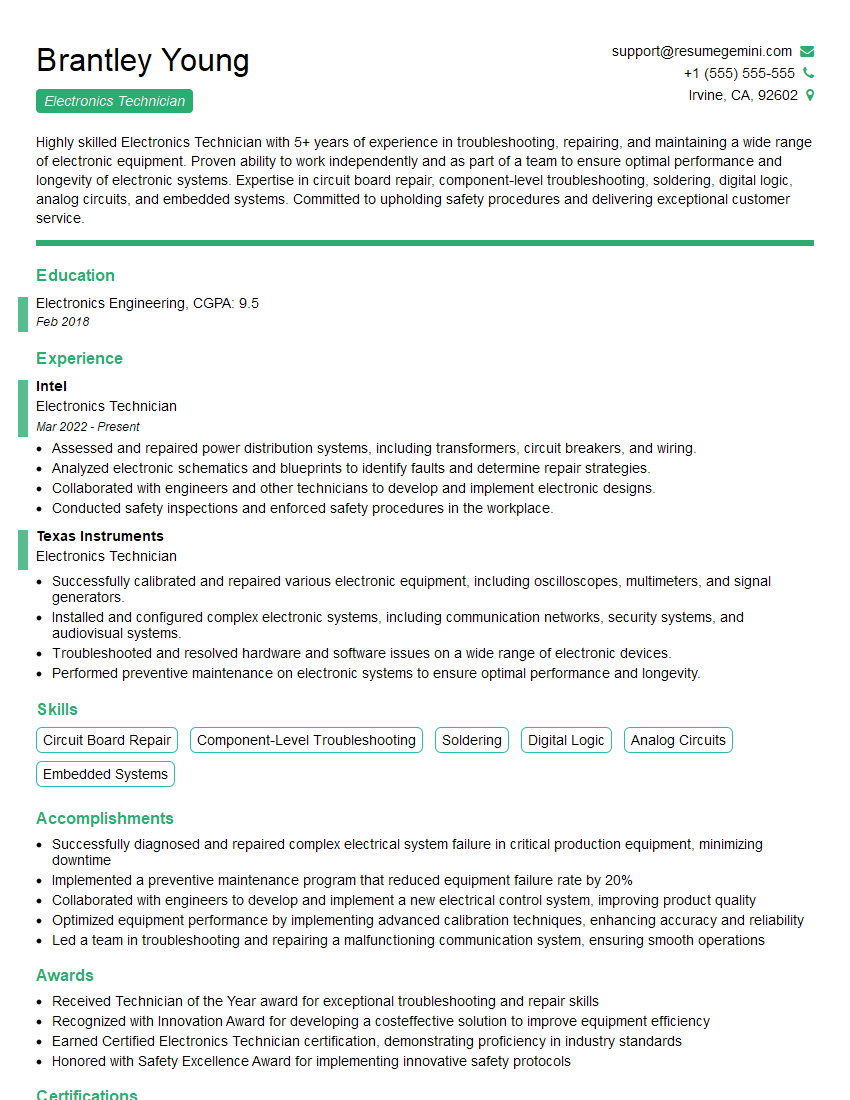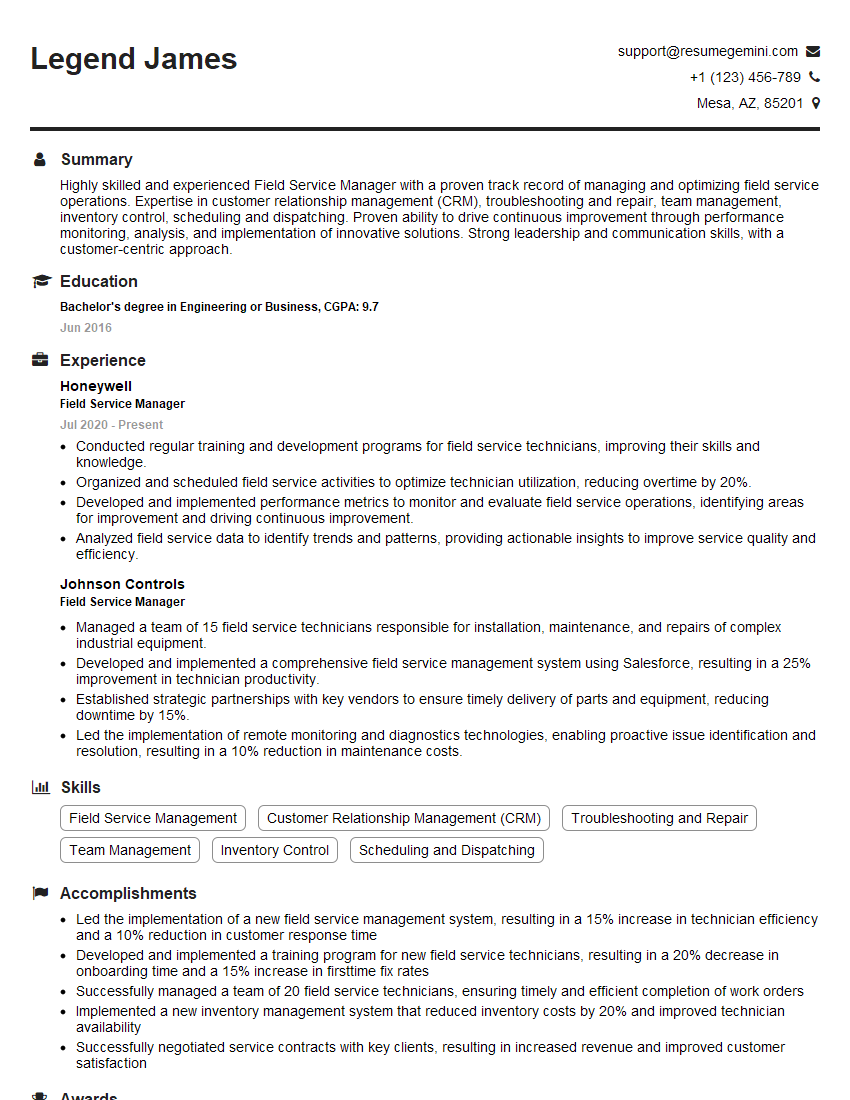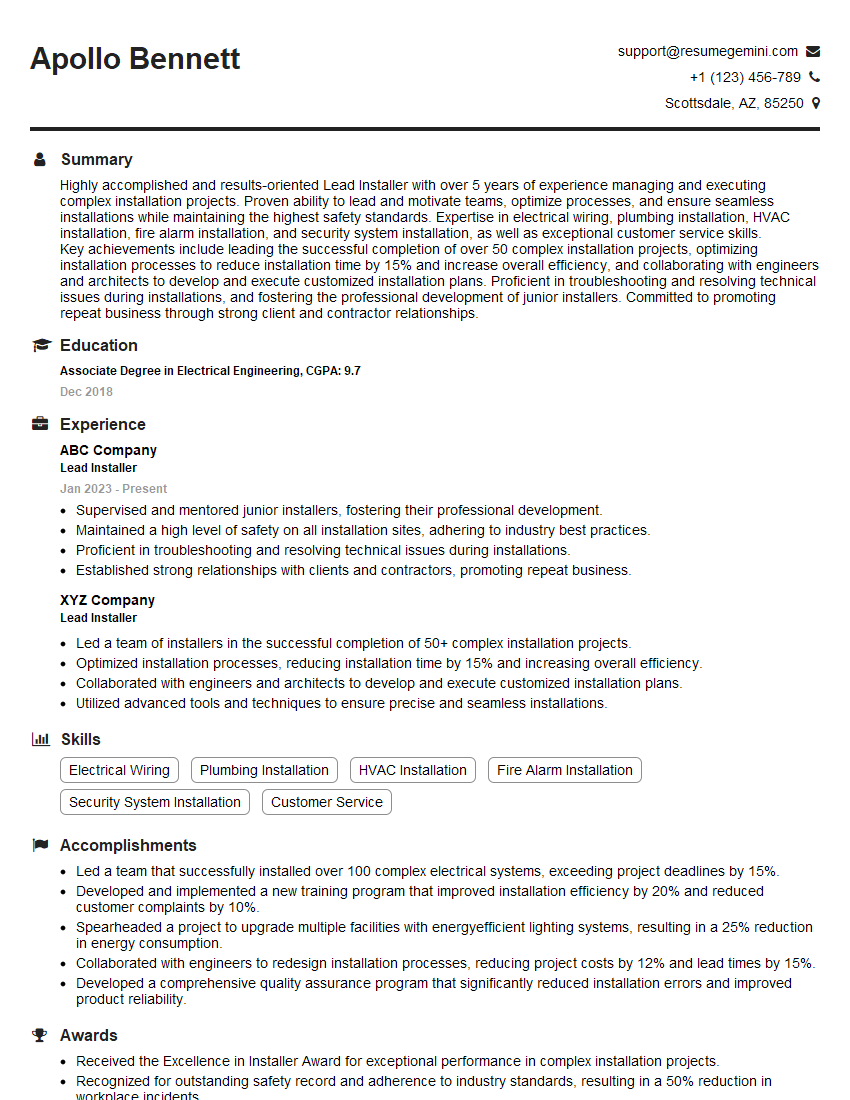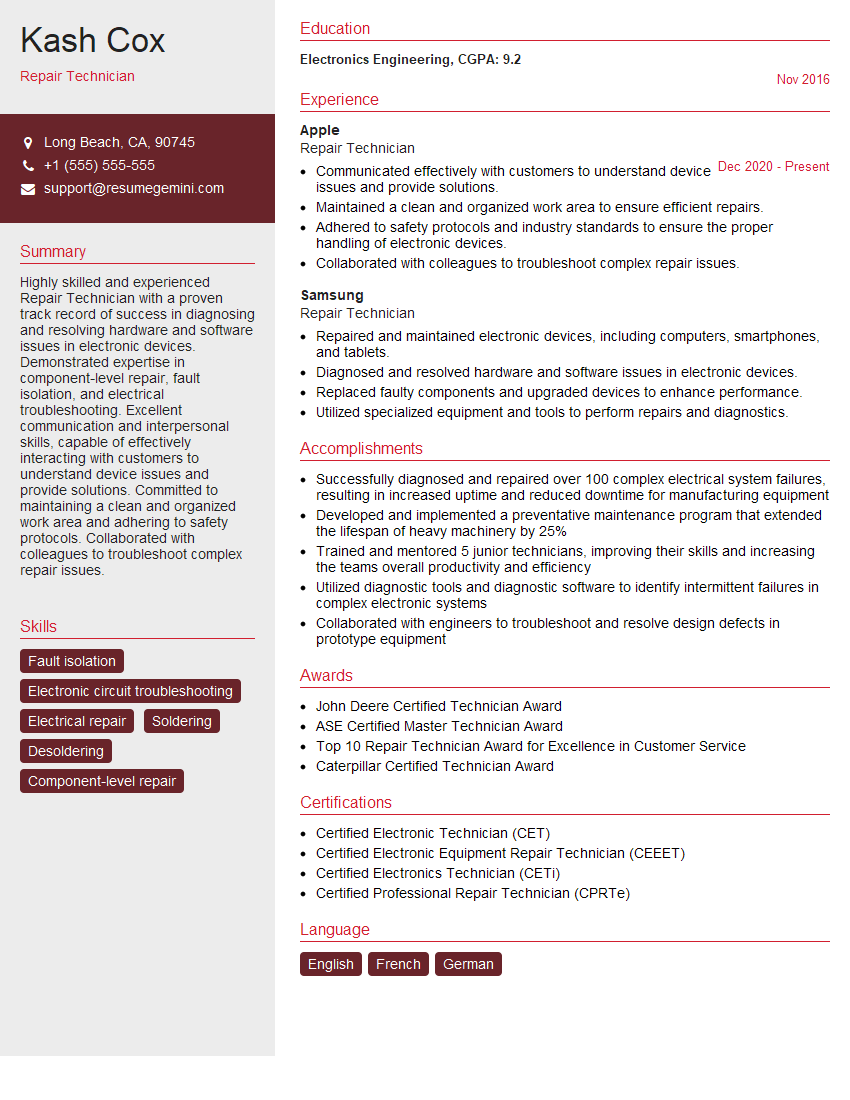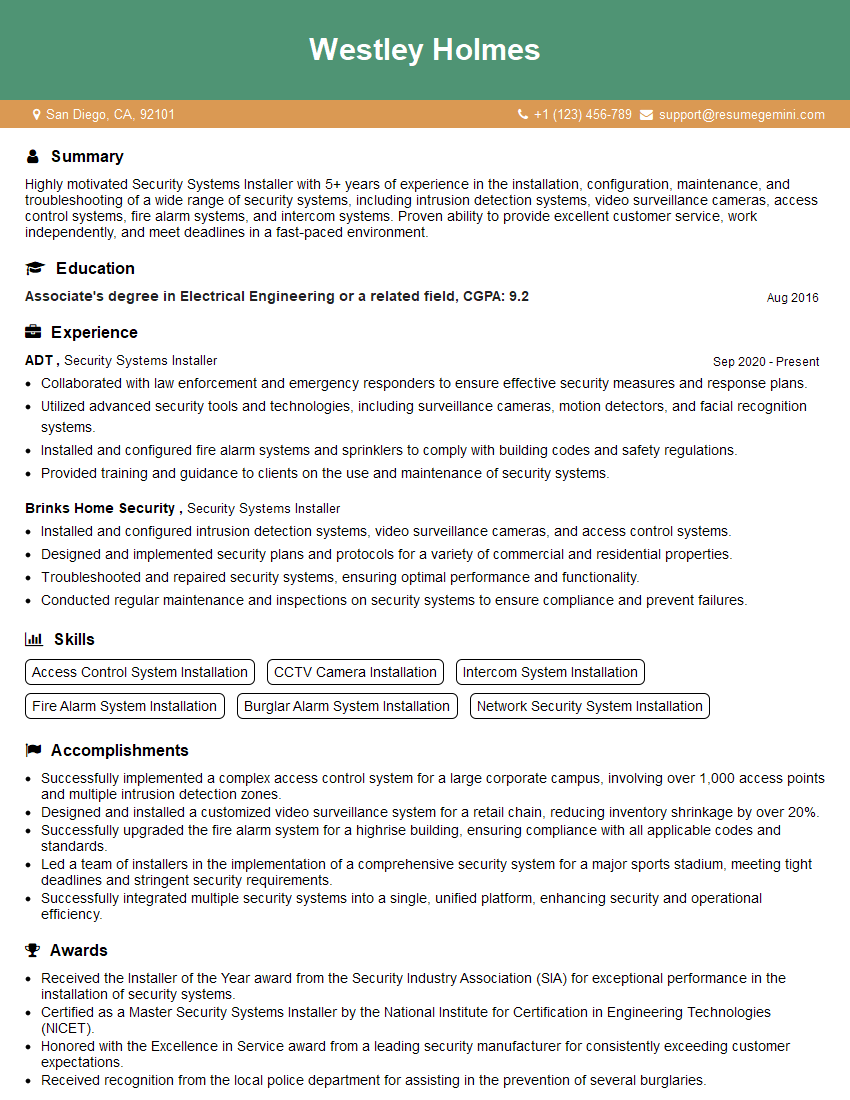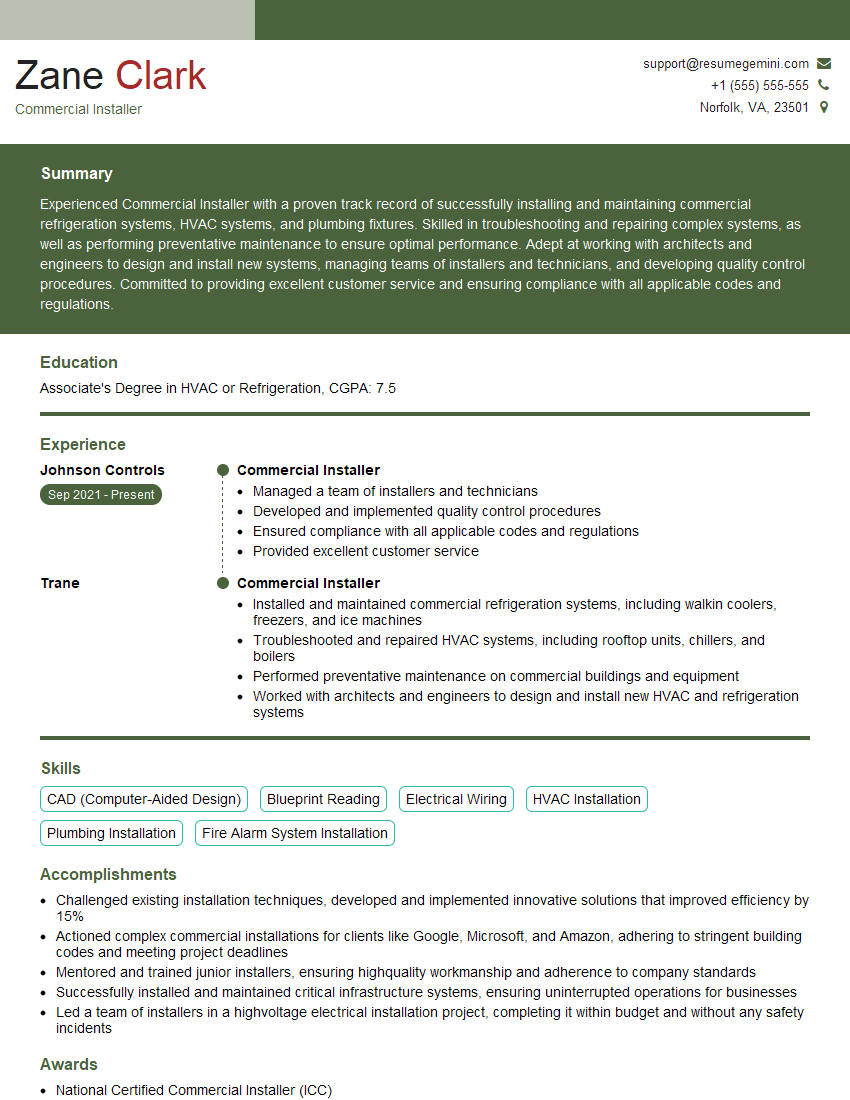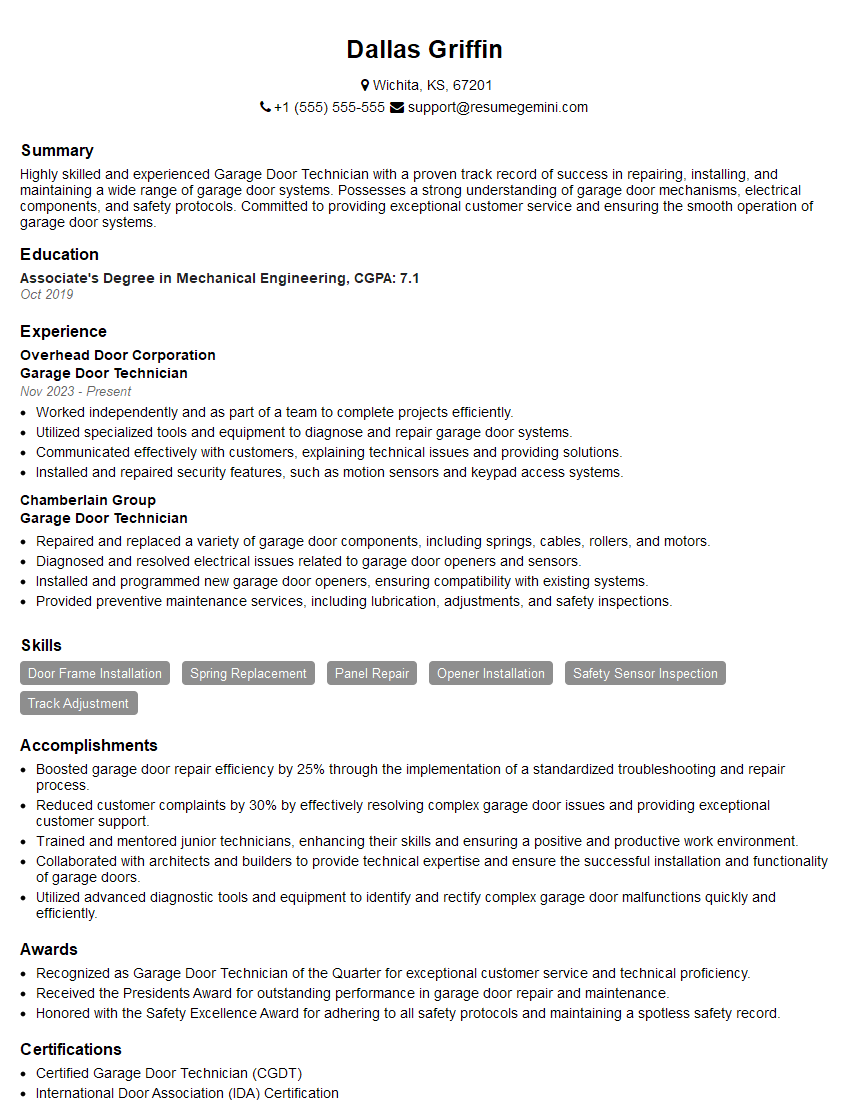Cracking a skill-specific interview, like one for Garage Door Remote Control Setup, requires understanding the nuances of the role. In this blog, we present the questions you’re most likely to encounter, along with insights into how to answer them effectively. Let’s ensure you’re ready to make a strong impression.
Questions Asked in Garage Door Remote Control Setup Interview
Q 1. Explain the different types of garage door opener remote controls.
Garage door opener remotes come in a variety of types, each with its own advantages and disadvantages. The most common types include:
- Fixed-Code Remotes: These older remotes use a pre-programmed code to communicate with the opener. They’re simple and inexpensive, but easily cloned, posing a security risk.
- Rolling Code Remotes: These are much more secure. Each time you press the button, a new, unique code is sent. Even if someone intercepts a code, it’s only valid for that single transmission. This is the most common type found in modern garage door openers.
- Miniature Remotes: These are smaller and more compact than standard remotes, often keychain-sized, offering convenience but sometimes sacrificing button size and ease of use.
- Multi-Frequency Remotes: These remotes can operate on multiple frequencies, allowing compatibility with different garage door openers. This is useful if you have multiple garage doors with different systems.
- Keypad Remotes: Instead of buttons, these use a numeric keypad for entry of a personal code. They provide a higher level of security than fixed-code remotes, but still not as secure as rolling-code remotes.
- Smartphone/App-Based Controls: Many modern systems allow you to control your garage door opener through a dedicated smartphone app, offering features like remote monitoring and scheduling.
Choosing the right type depends on your security needs and budget. Rolling code remotes are generally recommended for their security features.
Q 2. Describe the process of programming a new remote control to a garage door opener.
Programming a new remote is generally straightforward, but the exact process varies slightly depending on the brand and model of your garage door opener. Most often, this involves a ‘learn’ button on the opener’s motor unit. Here’s a general guideline:
- Locate the ‘Learn’ Button: This button is typically located on the motor unit of your garage door opener. It might be a small button, sometimes hidden behind a cover.
- Enter Programming Mode: Press and hold the ‘Learn’ button (consult your opener’s manual if unsure of its location or exact procedure). The opener’s indicator light will usually flash, confirming it’s in programming mode.
- Program the Remote: Within a short timeframe (usually a few seconds), press and hold the button on your new remote. Release after a second or two.
- Confirm Programming: The opener’s indicator light should change its pattern, usually blinking once or twice to confirm successful programming. Your new remote should now control your garage door. If not, repeat the process.
- Test the Remote: Open and close the garage door using the new remote to ensure it functions correctly.
Important Note: If your garage door opener requires a specific code, you’ll find this code on the existing remote. Your manual will usually specify this, but it’s possible certain high-end openers will not require it.
Q 3. How do you troubleshoot a remote control that is not working?
Troubleshooting a malfunctioning remote involves a systematic approach. Let’s break it down:
- Check Batteries: The most common cause is dead batteries. Replace them with fresh ones and retest.
- Check Remote’s Range: Try operating the remote from different locations. If it only works close to the opener, the signal might be weak, indicating potential interference or a failing remote.
- Check for Interference: Other electronic devices, especially those operating on similar frequencies (e.g., cordless phones), can interfere with the remote’s signal. Try moving these devices away from the opener and the remote.
- Check the Opener’s Antenna: Make sure the antenna on the garage door opener is correctly positioned and not damaged.
- Check the ‘Learn’ Button: If your remote worked previously, it’s possible it’s become unpaired from the opener. Try reprogramming the remote using the steps previously discussed. If reprogramming doesn’t work, the problem might lie in the opener itself.
- Check the Opener’s Power Supply: Ensure the power supply to the garage door opener is functioning correctly. A power outage or a tripped breaker can cause the opener to malfunction.
- Try a Known Working Remote: To isolate whether the problem is with the remote or the opener itself, test another known working remote with the same garage door opener.
If none of these steps resolve the issue, it is advisable to contact a garage door professional for assistance.
Q 4. What are the common causes of intermittent garage door opener remote malfunctions?
Intermittent malfunctions are often frustrating. Here are common culprits:
- Weak Batteries: Low battery power can lead to inconsistent signal transmission.
- Signal Interference: Other electronics or environmental factors can sporadically block or weaken the radio signal.
- Loose Connections: A loose wire or connection within the garage door opener itself can cause sporadic problems.
- Failing Remote Components: Internal components in the remote, such as the transmitter, may be failing, leading to intermittent operation.
- Antenna Issues: Problems with the opener’s antenna can cause inconsistent reception.
- Failing Opener Components: Issues within the opener itself, like a weak receiver circuit, can lead to intermittent communication problems with the remote.
Proper diagnosis may require professional help, especially if the problem seems tied to the opener itself.
Q 5. Explain the process of replacing a faulty garage door opener remote receiver.
Replacing a faulty garage door opener remote receiver is a task best left to a professional unless you have experience working with electrical systems and garage door openers. Improper installation can create safety hazards.
The process generally involves:
- Disconnecting Power: Always disconnect the power supply to the opener before starting any work to prevent electrical shock.
- Accessing the Receiver: Locate and access the receiver board inside the garage door opener’s motor housing. This usually involves removing panels and potentially some wiring.
- Removing the Old Receiver: Carefully disconnect the wiring connected to the old receiver, paying attention to how the wires are arranged for reconnection.
- Installing the New Receiver: Connect the new receiver according to the wiring diagram, ensuring that all connections are secure.
- Testing and Reprogramming: Reconnect the power supply and test the new receiver with the remotes. You may need to reprogram the remotes to the new receiver.
Without proper knowledge, this process risks creating additional issues, including safety concerns and causing damage to your opener.
Q 6. Describe the safety precautions you take when working with garage door openers.
Safety is paramount when working with garage door openers. Always:
- Disconnect Power: Always disconnect the power supply before performing any maintenance or repairs.
- Use Caution with Moving Parts: Garage doors are heavy and can cause serious injury if they fall unexpectedly. Never work on the opener while the door is in motion or the power is on.
- Use Proper Tools: Utilize appropriate tools for the task at hand. Never try to force or pry anything.
- Follow Manufacturer Instructions: Always consult the manufacturer’s instructions and safety guidelines before undertaking any work on the garage door opener.
- Seek Professional Help: If you’re unsure about anything, consult a qualified garage door technician. Safety should always be the top priority.
Remember, the risks associated with improper handling of garage door systems are substantial. If unsure, professional assistance is crucial.
Q 7. How do you determine the correct frequency for a garage door opener remote?
Determining the correct frequency for a garage door opener remote is crucial for compatibility. The frequency is usually specified on a sticker on the garage door opener’s motor unit itself. Look for specifications such as ‘frequency’ or ‘MHz’. The frequency is typically 300MHz to 400MHz, but other bands are possible. It can also be found in the owner’s manual of the opener unit.
If you can’t find the frequency information on the opener or in the manual, you can use these methods:
- Check the Existing Remote: Most remotes will have the frequency printed on them, sometimes subtly.
- Contact the Manufacturer: Use the model number of your garage door opener to contact the manufacturer directly to request the frequency information.
- Consult a Garage Door Professional: A garage door professional can identify the frequency using specialized equipment.
Remember, purchasing a replacement remote with a matching frequency is vital for correct functionality.
Q 8. What are the differences between rolling code and fixed code remotes?
The core difference between rolling code and fixed code garage door remotes lies in how they transmit signals. Think of it like this: a fixed code remote uses a single, unchanging code, much like a simple combination lock. Rolling code remotes, on the other hand, use a constantly changing code with each press, like a much more secure combination lock that changes its combination every time it’s used.
Fixed Code: These are older technology and vulnerable to cloning. If someone intercepts the code, they can easily replicate it and open your garage door. They are simpler and often cheaper.
Rolling Code: This modern technology offers enhanced security. Each time you press the button, a unique, unpredictable code is sent to the receiver. Even if someone intercepts a code, it’s useless for opening the door as it will have already changed by the next press. While more expensive initially, the enhanced security is well worth the investment.
Q 9. How do you address compatibility issues between different brands of garage door openers and remotes?
Compatibility issues between different brands often stem from variations in radio frequencies, encoding methods (rolling vs. fixed code), and signal protocols. Addressing these involves a few strategies.
- Check compatibility charts: Most manufacturers provide compatibility lists on their websites, specifying which remotes work with which openers.
- Use a universal remote: Universal remotes are designed to work with a wide range of garage door openers. Programming varies by brand, but they typically involve learning codes or using dip switches for compatibility.
- Consider a new opener or remote: If compatibility remains an issue despite attempts with a universal remote, a compatible opener or remote from the same brand might be the most straightforward solution. The cost of this could be less than the ongoing frustrations of incompatible systems.
- Consult a professional: A garage door technician can diagnose specific compatibility issues and suggest the most efficient solution.
Q 10. Explain how to install a multi-function garage door remote control.
Installing a multi-function garage door remote, often a universal remote, usually involves these steps:
- Refer to the manual: Each remote has its own specific instructions. The manual is your best guide.
- Install batteries: Insert fresh batteries into the remote.
- Learn the code (most common): Most multi-function remotes use a ‘learn’ function. This involves holding down a button on both the remote and the garage door opener until the opener registers the code. Your opener manual will indicate the exact process.
- Dip switches (less common): Some older remotes use dip switches. You set them to match the codes of the opener (again, check the manuals).
- Test the remote: Try opening and closing the garage door to ensure the remote is correctly programmed.
Remember to always consult your remote’s instruction manual as the exact steps can vary depending on the model and brand.
Q 11. What are the steps involved in replacing a broken remote control button?
Replacing a broken remote control button is generally not a simple DIY fix. Most remote controls are designed as sealed units. The buttons are usually integrated circuits, meaning replacing individual buttons isn’t feasible.
The best approach is to replace the entire remote: It’s more cost-effective and reliable. You’ll want to find an identical replacement or one from the same brand that matches your current opener.
Professional Repair: In rare cases, an experienced electronics technician might be able to repair a severely damaged remote, but it’s often more expensive than replacement.
Q 12. Describe the process of adding a new remote to an existing system with multiple remotes.
Adding a new remote to an existing system involves utilizing the ‘learn’ button on your garage door opener. This differs slightly by brand, so referring to your opener’s manual is crucial.
- Locate the ‘learn’ button: This button is usually located on the motor unit of your garage door opener.
- Press the ‘learn’ button: Follow the opener’s instructions for activating the learning mode. It usually involves holding the button down until a light blinks.
- Program the new remote: Press and hold the button on your new remote until the opener’s light changes or confirms that the new code is accepted. This often involves a few blinks or beeps.
- Test the new remote: Attempt to open and close the garage door using the newly added remote.
If you’re adding more than one remote, repeat steps 2-4 for each additional one.
Q 13. How do you handle a situation where a remote is not responding despite new batteries?
If a remote isn’t responding despite new batteries, the problem could be:
- Weak signal: The distance between the remote and the opener could be excessive or there might be interference from other devices or physical obstructions (like thick walls).
- Dead opener’s receiver: The receiver within your garage door opener might be faulty.
- Remote malfunction: Internal components could have failed, even if the batteries are new.
- Programming issues: The remote might not be correctly programmed to your opener.
Troubleshooting: Try moving closer to the opener, remove any potential interference, check the opener’s lights to ensure it receives power and the receiver is working, and re-program the remote. If these steps don’t resolve the issue, consider professional assistance.
Q 14. Explain the use of diagnostic tools in troubleshooting garage door remote issues.
Diagnostic tools for troubleshooting garage door remote issues are primarily focused on assessing the signal strength and identifying interference.
- Signal meter: A specialized signal meter can measure the radio frequency signal strength emitted by the remote. This helps in determining whether the signal is weak or nonexistent.
- Radio frequency analyzer: A more advanced tool, this can identify specific frequencies and pinpoint potential sources of interference, like other wireless devices operating on the same or similar frequencies.
- Multimeter: This can be used to check the voltage of the batteries in the remote and also check for power and continuity within the opener’s circuitry.
While homeowners usually don’t require these specialized tools, garage door professionals utilize them for in-depth diagnostics, especially when dealing with complex or intermittent problems.
Q 15. What are the common security vulnerabilities associated with garage door remote controls?
Garage door remote controls, while convenient, aren’t immune to security vulnerabilities. The most common issue is the use of easily-guessable or easily-copied rolling codes. Older systems, particularly those using fixed codes, are extremely vulnerable to cloning. Imagine someone recording your signal and then replaying it to open your garage – that’s a real threat with older technology. Another vulnerability is signal jamming. A malicious actor could use a device to temporarily block your remote’s signal, preventing you from closing your garage door. Finally, physical theft of the remote itself is a straightforward security breach.
Modern systems mitigate these risks with more sophisticated rolling codes and encryption. However, it’s crucial to regularly update your garage door opener’s firmware if possible, as this often includes security patches. Choosing a system with strong encryption and potentially using a keypad or smartphone app alongside a remote will further enhance security. Think of it like adding multiple layers of security to your home – one breach point is less concerning when you have others in place.
Career Expert Tips:
- Ace those interviews! Prepare effectively by reviewing the Top 50 Most Common Interview Questions on ResumeGemini.
- Navigate your job search with confidence! Explore a wide range of Career Tips on ResumeGemini. Learn about common challenges and recommendations to overcome them.
- Craft the perfect resume! Master the Art of Resume Writing with ResumeGemini’s guide. Showcase your unique qualifications and achievements effectively.
- Don’t miss out on holiday savings! Build your dream resume with ResumeGemini’s ATS optimized templates.
Q 16. How can you improve the range of a garage door opener remote?
Boosting the range of your garage door opener remote involves several strategies. First, ensure the remote’s batteries are fresh – weak batteries dramatically reduce signal strength. Think of a battery as the remote’s engine; it needs sufficient power to send a strong signal. Next, consider the location of your garage door opener’s receiver. Obstacles like thick walls, metal objects, and even trees can significantly attenuate the signal. Try positioning the receiver in a more open, unobstructed location if possible. You may also want to investigate any potential sources of radio frequency interference (RFI), such as microwaves or other wireless devices. Finally, if none of these steps improve the range, consider replacing the remote or receiver. An aged receiver may have a degraded antenna, reducing its sensitivity.
Q 17. Explain the process of resetting a garage door opener’s memory.
Resetting a garage door opener’s memory erases all previously programmed remotes, effectively starting fresh. The process varies slightly depending on the brand and model, but typically involves locating a small button or switch, often labeled ‘Learn’ or ‘Program’, on the garage door opener motor unit. This button is usually inside the garage door unit itself. Consult your owner’s manual for exact instructions, but generally, you’ll need to press and hold this button for a specific duration, often until the indicator light on the motor unit begins to blink or change state. Once this happens, the unit is in programming mode. You then need to follow the instructions to pair your new remote by pressing specific buttons.
For example, with some LiftMaster models, you press and hold the learn button until the light blinks, then press the button on your new remote. If successful, the light will change to signal successful programming. The entire process usually takes only a few minutes and provides a good solution for troubleshooting remote issues or for adding new remotes.
Q 18. How do you handle a situation where the remote’s signal is being interfered with?
If your garage door remote’s signal is being interfered with, troubleshooting is key. First, try moving further away from potential sources of interference such as microwaves, cordless phones, or other wireless devices. The interference could be causing the signal to be weak or garbled. Secondly, try using your remote from different locations around your property to pinpoint areas where the signal is strongest and weakest, to determine if there are obstacles blocking the path to the receiver. If the issue persists, check for damage to the remote’s antenna (if it has one) or consider a new set of batteries. If interference still persists, you may have a more significant issue such as a faulty receiver or even external interference that requires further investigation. You could try using a different frequency for the garage door opener if possible.
Q 19. What are the different types of antenna used in garage door remote systems?
Garage door remote systems typically use internal antennas, rather than external ones like you might see on a radio. These antennas are often small, printed circuit board (PCB) antennas built directly into the remote’s circuit board. The type of antenna used is determined by the frequency and other design factors of the remote’s electronics. Common types might include patch antennas, dipole antennas, or helical antennas – though you are unlikely to see these described explicitly. They are often optimized for the specific frequency range used by the system, minimizing size and maximizing efficiency. Most users don’t need to concern themselves with the specifics of the antenna type, but understanding that the antenna is a critical part of the signal transmission is beneficial for troubleshooting.
Q 20. How do you test the signal strength of a garage door opener remote?
Testing the signal strength of a garage door opener remote is primarily a matter of observation and simple testing. There isn’t a precise measurement you can easily obtain. The best way is to test the distance over which the remote reliably opens and closes the door. Start near the garage door and gradually move farther away, noting the point at which the signal becomes unreliable. Obstacles should also be considered. If the distance is significantly shorter than expected, there’s a good chance there is signal degradation. Another test would be to compare signal strength at different locations and times, to look for any patterns indicating interference. This method provides a practical assessment of signal strength and range in real-world conditions.
Q 21. What are the environmental factors that affect the performance of garage door remotes?
Environmental factors play a crucial role in the performance of garage door remotes. Heavy rain, snow, or fog can attenuate the radio frequency signal, reducing range and reliability. Imagine trying to shout across a busy street – the ambient noise makes it harder for your message to get through. Similarly, environmental noise interferes with the remote’s signal. Temperature extremes can also affect the remote’s battery life and the performance of the electronics. And of course, physical obstacles like walls, trees, and large metal objects significantly weaken the signal. Therefore, placing the receiver in an optimal position – somewhere high and centrally located to reduce interference – is key to improving performance. Understanding these limitations can help in diagnosing and resolving range problems.
Q 22. Explain the process of installing a keypad entry system for a garage door.
Installing a keypad entry system for your garage door is a straightforward process that enhances security and convenience. It typically involves connecting a wired or wireless keypad to your existing garage door opener.
- Step 1: Power Down: Always disconnect the power to your garage door opener before starting any installation. Safety first!
- Step 2: Locate the Wiring: For a wired keypad, you’ll need to locate the wiring terminals on your garage door opener. These terminals usually connect to the ‘keypad’ or ‘accessory’ ports. Consult your opener’s manual for precise locations.
- Step 3: Wire the Keypad: Carefully connect the wires from the keypad to the corresponding terminals on the opener. The color-coding of the wires should match your garage door opener’s specifications. If it’s a wireless keypad, you’ll pair it with the opener using the programming button on the opener, following the keypad’s instructions.
- Step 4: Program the Keypad: Once wired (or paired wirelessly), program the keypad using the instructions provided with your specific model. This usually involves entering a unique PIN code.
- Step 5: Test and Secure: Test the keypad thoroughly. Ensure the PIN code works, and the door opens and closes correctly. Securely mount the keypad to a convenient and visible location.
Example: I recently installed a Chamberlain keypad on a LiftMaster opener. The wiring was quite simple, involving two wires (common and signal). Following the instructions precisely ensured a seamless installation.
Q 23. Describe the process of installing a remote control system for a commercial garage door.
Commercial garage door remote control systems differ from residential ones due to higher security requirements and often involve multiple access points and users. Installation is more complex and often requires professional expertise.
- Step 1: Assess the Needs: The first step involves determining the number of remote controls needed, the type of access control (keypads, card readers, etc.), and the integration with existing security systems. A site survey is crucial.
- Step 2: Choose the System: Selecting a robust and reliable system tailored to the commercial environment is critical. This often involves high-quality commercial-grade openers with features like advanced security protocols and multi-user access options.
- Step 3: Installation: This might include installing the opener itself (potentially heavy-duty units), wiring for multiple access points (keypads at multiple entrances), and configuring the system to manage user codes or access cards. Specialized tools and knowledge might be required.
- Step 4: Programming and Testing: Program each remote control and access point individually. Testing involves ensuring every component is working as expected and accessing the system from all assigned access points.
- Step 5: Documentation and Training: Create clear documentation outlining the system’s operation and maintenance. Train users on proper usage and security protocols.
Example: I’ve worked on commercial projects involving Linear operators with multiple remote controls and keypad systems for loading docks, providing secure access for various personnel with different levels of authorization.
Q 24. How do you ensure compliance with safety regulations during installation?
Safety is paramount during any garage door installation or repair. Adherence to safety regulations is crucial to prevent accidents and injuries.
- Power Disconnection: Always disconnect the power source to the garage door opener before performing any work. This prevents accidental operation and electric shock.
- Proper Grounding: Ensure all wiring is properly grounded to avoid electrical hazards. This reduces the risk of short circuits and fires.
- Use of Safety Equipment: Wear appropriate personal protective equipment (PPE), including safety glasses, gloves, and possibly a hard hat, when working with tools or handling heavy components.
- Understanding Opener Mechanisms: Before working on the opener, familiarize yourself with its mechanics. This helps in identifying potential hazards and avoiding dangerous situations.
- Compliance with Local Codes: Consult local building codes and regulations to ensure that the installation adheres to all safety standards.
Example: I always follow the ‘lockout/tagout’ procedure before starting any work on a garage door opener, ensuring the power supply is completely disconnected and safely secured to prevent accidental activation.
Q 25. Explain the importance of regularly maintaining garage door remote systems.
Regular maintenance is essential for the longevity and optimal performance of your garage door remote system, improving security and preventing costly repairs.
- Battery Replacement: Regularly check and replace batteries in your remotes as needed. Weak batteries can lead to unreliable operation.
- Cleaning: Keep the remote control clean, preventing dirt and debris from interfering with its functionality. Don’t submerge it in water.
- Testing: Periodically test all remote controls and keypads to ensure they function correctly. This helps catch problems early.
- Inspecting Wiring: Inspect the wiring and connections of wired keypads or access points for any damage or loose connections. Repair or replace any damaged wires.
- Checking the Opener: Check the garage door opener for proper functioning, ensuring it responds correctly to the remotes and keypads.
Example: I recommend checking remote batteries every 3-6 months, depending on usage, and conducting a full system test at least annually to catch any problems before they become serious.
Q 26. What are the potential risks associated with improperly installed garage door remotes?
Improperly installed garage door remotes pose several risks:
- Security Vulnerabilities: Incorrect installation can leave the system vulnerable to hacking or unauthorized access, compromising the security of your garage and property.
- Malfunctioning: Poorly installed remotes may malfunction, leading to the garage door failing to open or close properly, resulting in inconvenience or potential damage.
- Electrical Hazards: Improper wiring can create electrical hazards, increasing the risk of fire or electric shock.
- Mechanical Damage: Forceful or incorrect installation can damage the garage door opener, remotes, or other components, necessitating costly repairs or replacements.
- Safety Risks: A malfunctioning garage door due to poor installation can pose a serious safety risk, especially to children or pets.
Example: A poorly connected keypad could result in erratic behavior or even fail to function, leaving you locked out of your garage. Improper grounding could potentially lead to a fire hazard.
Q 27. How do you handle customer complaints about faulty remote control systems?
Handling customer complaints about faulty remote systems requires a systematic and professional approach.
- Listen Empathetically: First, I listen carefully to understand the customer’s issue and express empathy for their frustration.
- Gather Information: I collect detailed information about the problem, including the type of remote, opener model, installation details, and the nature of the malfunction.
- Troubleshooting: I systematically troubleshoot the problem, starting with simple checks (e.g., battery replacement) before moving to more complex solutions.
- Provide Solutions: Based on the troubleshooting, I offer solutions, which could include repairing the remote, replacing components, or recommending a full system check.
- Follow Up: Once the issue is resolved, I follow up with the customer to ensure they are satisfied. This strengthens customer relationships and builds trust.
Example: I recently received a complaint about a remote not working. After troubleshooting, I determined the problem was a weak battery. A simple battery replacement fixed the issue, and I followed up with a phone call to confirm the solution worked.
Q 28. Describe your experience with different brands and models of garage door openers and remote controls.
Over my career, I’ve worked with various brands and models of garage door openers and remote controls.
- LiftMaster/Chamberlain: These are popular brands known for their reliability and range of models, from basic to more advanced systems. I’m comfortable working with their entire product line.
- Genie: Genie openers are also widely used, particularly known for their quiet operation. I’ve successfully installed and serviced their remotes and access controls.
- Craftsman: Craftsman offers a range of openers and remotes with varying features. I’m adept at working with their products, understanding their specific programming procedures.
- Linear: Linear is a prominent brand often used in commercial settings, and I have experience with their advanced opener systems and multi-user access control setups.
My experience spans both residential and commercial applications, and I’m adept at understanding the specific needs and complexities of each brand. I prioritize understanding the specific nuances of each brand and model to provide the best possible service to my clients.
Key Topics to Learn for Garage Door Remote Control Setup Interview
- Understanding Different Remote Control Technologies: Explore the various technologies used in garage door remote controls, including rolling code, fixed code, and newer wireless protocols. Consider the advantages and disadvantages of each.
- Installation and Programming Procedures: Master the practical steps involved in installing and programming different types of garage door openers and remote controls. This includes connecting to power, pairing remotes, and troubleshooting common installation issues.
- Troubleshooting Common Problems: Develop expertise in diagnosing and resolving frequent problems, such as range issues, intermittent connectivity, and programming errors. Practice identifying the root cause and implementing effective solutions.
- Safety Procedures and Regulations: Familiarize yourself with safety regulations and best practices related to garage door installation and maintenance. Understand the importance of safety features and how to ensure compliance.
- Security Considerations: Understand the security implications of different remote control technologies and how to mitigate vulnerabilities. This includes learning about code hopping, frequency hopping, and other security measures.
- Working with Different Garage Door Opener Brands: Gain familiarity with the specific programming procedures and troubleshooting techniques for various leading brands of garage door openers. Highlight your adaptability to different systems.
- Understanding Basic Electronics and Circuitry: Develop a foundational understanding of the electrical components and circuitry involved in garage door opener systems. This will help you troubleshoot more effectively.
Next Steps
Mastering garage door remote control setup opens doors to exciting opportunities in the home automation and security industries. Proficiency in this area demonstrates valuable technical skills and problem-solving abilities, highly sought after by employers. To significantly boost your job prospects, create an ATS-friendly resume that showcases your expertise effectively. ResumeGemini is a trusted resource that can help you build a professional and impactful resume tailored to highlight your skills. Examples of resumes specifically crafted for roles involving Garage Door Remote Control Setup are available, allowing you to tailor your application perfectly. Invest the time to craft a compelling resume – it’s your first impression with potential employers.
Explore more articles
Users Rating of Our Blogs
Share Your Experience
We value your feedback! Please rate our content and share your thoughts (optional).
What Readers Say About Our Blog
Interesting Article, I liked the depth of knowledge you’ve shared.
Helpful, thanks for sharing.
Hi, I represent a social media marketing agency and liked your blog
Hi, I represent an SEO company that specialises in getting you AI citations and higher rankings on Google. I’d like to offer you a 100% free SEO audit for your website. Would you be interested?


